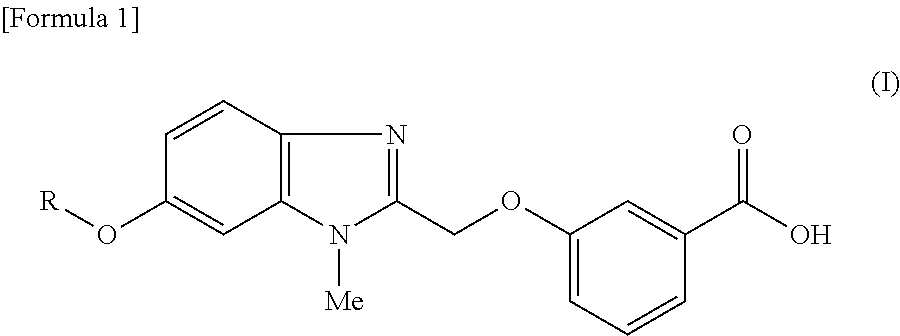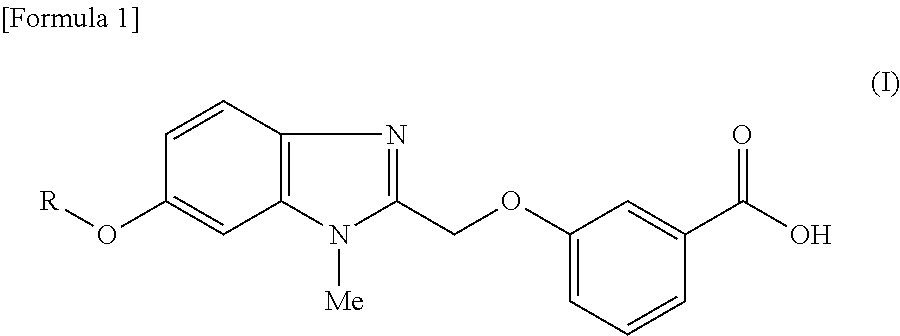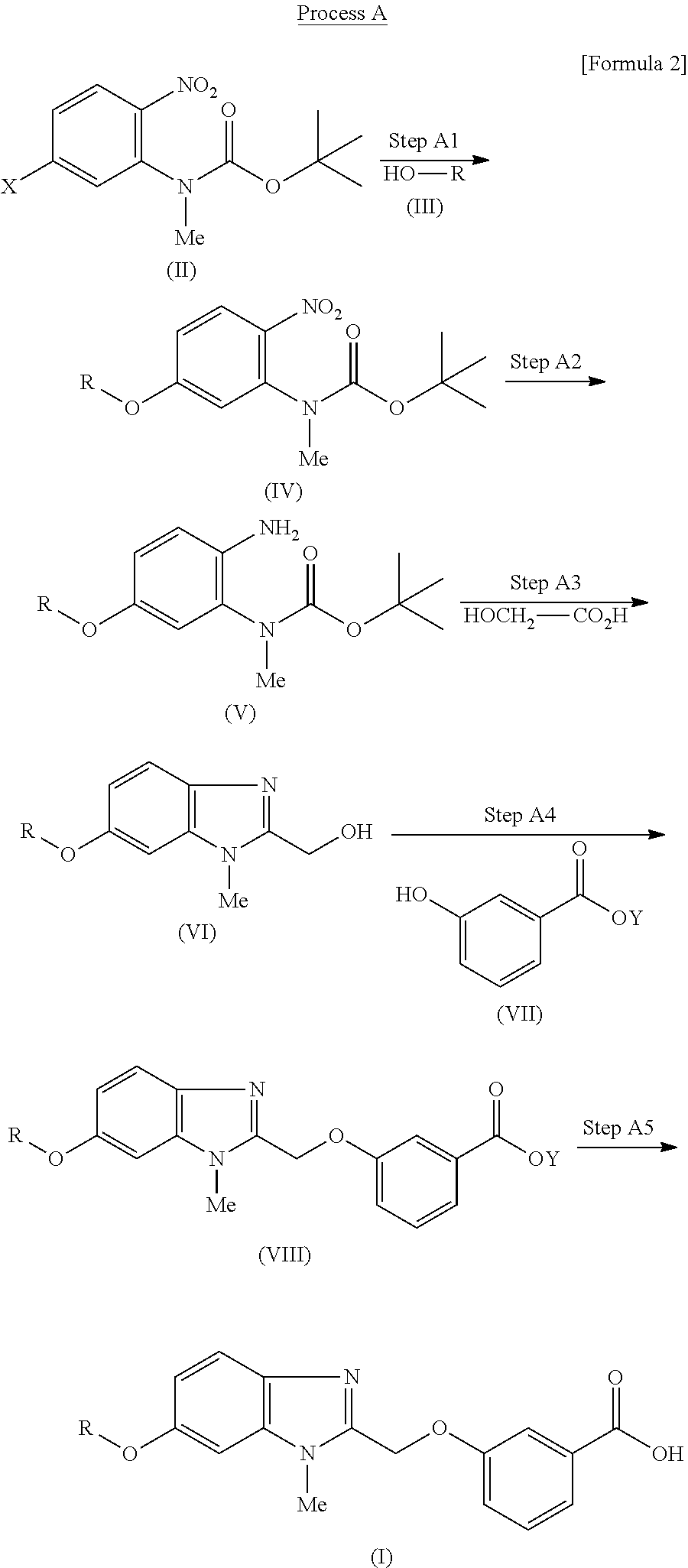Pyridine derivative
a pyridine and derivative technology, applied in the field of medicine, can solve the problems of increasing medical costs, increasing the side effects of thiazolidinedione drugs, and the number of patients, and achieve the effects of improving insulin resistance, excellent hypoglycemia, and improving carbohydrate or lipid metabolism
- Summary
- Abstract
- Description
- Claims
- Application Information
AI Technical Summary
Benefits of technology
Problems solved by technology
Method used
Image
Examples
example 1
3-({6-[(3-Chloropyridin-2-yl)oxy]-1-methyl-1H-benzimidazol-2-yl}methoxy)benzoic acid
[0311]
(1a) tert-Butyl {5-[(4-methoxybenzyl)oxy]-2-nitrophenyl}methylcarbamate
[0312]Sodium hydride (63%, 25 g, 656 mmol) was added to a solution of 4-methoxybenzyl alcohol (90.3 g, 654 mmol) and tert-butyl (5-chloro-2-nitrophenyl)methylcarbamate (US200216506 A1, 156 g, 544 mmol) in DMF (1.4 L) at room temperature, and the mixture was stirred at 80° C. for four hours. After leaving to cool, water (1.5 L) was added to the reaction mixture. The precipitated solid was collected by filtration to obtain the title compound (209 g, 99%) as a yellow solid.
[0313]1H-NMR (400 MHz, CDCl3): δ ppm: 1.28 (9H, s), 3.25 (3H, s), 3.81 (3H, s), 5.04 (2H, s), 6.79-6.95 (4H, m), 7.29-7.37 (2H, m), 7.91-8.03 (1H, m).
(1b) tert-Butyl {2-amino-5-[(4-methoxybenzyl)oxy]phenyl}methylcarbamate
[0314]A solution of tert-butyl {5-[(4-methoxybenzyl)oxy]-2-nitrophenyl}methylcarbamate produced in Example (1a) (209 g, 538 mmol), iron powd...
example 2
3-({6-[(3-Ethylpyridin-2-yl)oxy]-1-methyl-1H-benzimidazol-2-yl}methoxy)benzoic acid
[0330]
(2a) Methyl 3-({6-[(3-bromopyridin-2-yl)oxy]-1-methyl-1H-benzimidazol-2-yl}methoxy)benzoate
[0331]The reaction and post-treatment were carried out according to Example (1f) using methyl 3-[(6-hydroxy-1-methyl-1H-benzimidazol-2-yl)methoxy]benzoate produced in Example (1e) (3.12 g, 10 mmol), 3-bromo-2-fluoropyridine (1.94 g, 11 mmol), copper iodide (0.19 g, 1.0 mmol), 1,10-phenanthroline (0.18 g, 1.0 mmol), cesium carbonate (9.77 g, 30 mmol) and DMF (50 mL) to obtain the title compound (2.19 g, 47%) as a white solid.
[0332]1H-NMR (400 MHz, CDCl3): δ ppm: 3.87 (3H, s), 3.93 (3H, s), 5.42 (2H, s), 6.91 (1H, dd, J=5.1, 8.6 Hz), 7.10 (1H, dd, J=2.7, 8.6 Hz), 7.21 (1H, d, J=2.4 Hz), 7.30 (1H, dd, J=0.8, 8.2 Hz), 7.38 (1H, t, J=7.8 Hz), 7.68 (1H, d, J=7.8 Hz), 7.72-7.73 (1H, m), 7.80 (1H, d, J=8.6 Hz), 7.96 (1H, dd, J=2.0, 8.6 Hz), 8.06 (1H, dd, J=1.6, 4.7 Hz).
(2b) Methyl 3-({6-[(3-ethylpyridin-2-yl)oxy]-...
example 3
3-({6-[(6-Methoxy-5-methylpyridin-2-yl)oxy]-1-methyl-1H-benzimidazol-2-yl}methoxy)benzoic acid
[0339]
(3a) Methyl 3-({6-[(5-bromo-6-chloropyridin-2-yl)oxy]-1-methyl-1H-benzimidazol-2-yl}methoxy)benzoate
[0340]The reaction and post-treatment were carried out according to Example (1f) using methyl 3-[(6-hydroxy-1-methyl-1H-benzimidazol-2-yl)methoxy]benzoate produced in Example (1e) (1.56 g, 5.0 mmol), 3-bromo-2-chloro-6-fluoropyridine (1.16 g, 5.50 mmol), copper iodide (0.10 g, 0.50 mmol), 1,10-phenanthroline (0.09 g, 0.50 mmol), cesium carbonate (4.89 g, 15 mmol) and DMF (30 mL) to obtain the title compound (1.70 g, 68%) as a white solid.
[0341]1H-NMR (400 MHz, DMSO-d6): δ ppm: 3.84 (3H, s), 3.86 (3H, s), 5.50 (2H, s), 6.98 (1H, dd, J=0.8, 9.0 Hz), 7.05 (1H, d, J=9.9 Hz), 7.42-7.52 (3H, m), 7.59 (1H, d, J=8.2 Hz), 7.67-7.71 (2H, m), 8.22 (1H, dd, J=1.6, 8.6 Hz).
(3b) Methyl 3-({6-[(5-bromo-6-methoxypyridin-2-yl)oxy]-1-methyl-1H-benzimidazol-2-yl}methoxy)benzoate
[0342]Methyl 3-({6-[(5-brom...
PUM
| Property | Measurement | Unit |
|---|---|---|
| temperature | aaaaa | aaaaa |
| temperature | aaaaa | aaaaa |
| reaction time | aaaaa | aaaaa |
Abstract
Description
Claims
Application Information
 Login to View More
Login to View More - R&D
- Intellectual Property
- Life Sciences
- Materials
- Tech Scout
- Unparalleled Data Quality
- Higher Quality Content
- 60% Fewer Hallucinations
Browse by: Latest US Patents, China's latest patents, Technical Efficacy Thesaurus, Application Domain, Technology Topic, Popular Technical Reports.
© 2025 PatSnap. All rights reserved.Legal|Privacy policy|Modern Slavery Act Transparency Statement|Sitemap|About US| Contact US: help@patsnap.com



